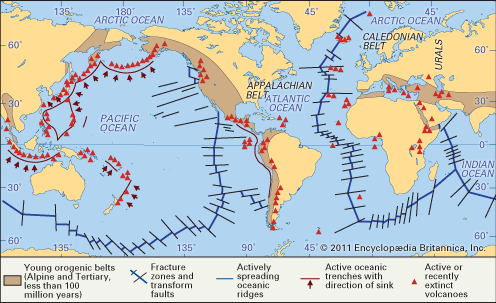continental shield
continental shield, any of the large stable areas of low relief in the Earth’s crust that are composed of Precambrian crystalline rocks. The age of these rocks is in all cases greater than 540 million years, and radiometric age dating has revealed some that are as old as 2 to 3 billion years.
Shield areas in general are regarded as continental nuclei, the observation often being made that most continental shields are bordered by belts of folded rocks of post-Precambrian age. One school of thought holds that Earth history can be interpreted in terms of the concept of continental accretion—i.e., that belts of successively younger rocks have undergone intense deformation in episodes of mountain building and have become welded onto the borders of the preexisting shields. In this way, the growth of continents might have occurred through geologic time.
Continental shields, as the name implies, occur on each of the continents. One of the best known is the Canadian Shield, which extends from Lake Superior on the south to the Arctic Islands on the north, and from western Canada eastward, to include most of Greenland. In South America, the principal shield area is called the Amazonian Shield. It occupies much of the eastern bulge of the continent. Smaller areas of Precambrian rocks to the north and south of the Amazonian Shield are designated the Guiana and Platian shields, respectively.
The Baltic, or Fennoscandian, Shield occupies most of Finland and Sweden, as well as eastern Norway. It is bordered on the west by the Caledonian Belt of younger, folded rocks. Shield areas are not recognized in central Europe, but farther south nearly one-half of the continent of Africa exhibits Precambrian rocks in outcrop (at the surface). The African Shield, sometimes called the Ethiopian Shield, extends eastward to include western Saudi Arabia and the eastern half of Madagascar.
The southern two-thirds of peninsular India, most of the western half of Australia, and the eastern segment of Antarctica are also areas of continental shields. These areas of Precambrian rocks are termed, appropriately, the Indian Shield, the Australian Shield, and the Antarctic Shield.
In Asia the name Angaran Shield is applied to a large stable block bounded by the Lena and Yenisey rivers on the east and west and by the Arctic Ocean and Lake Baikal to the north and south. An area in China and North Korea is sometimes designated the China-Korean Shield. The Angaran Shield is bordered on the west by a belt of folded rocks that presently comprise the Ural Mountains and on the south by the Himalayas; these mobile zones separate the Angaran Shield from the Baltic Shield to the west and the Indian Shield to the south.








